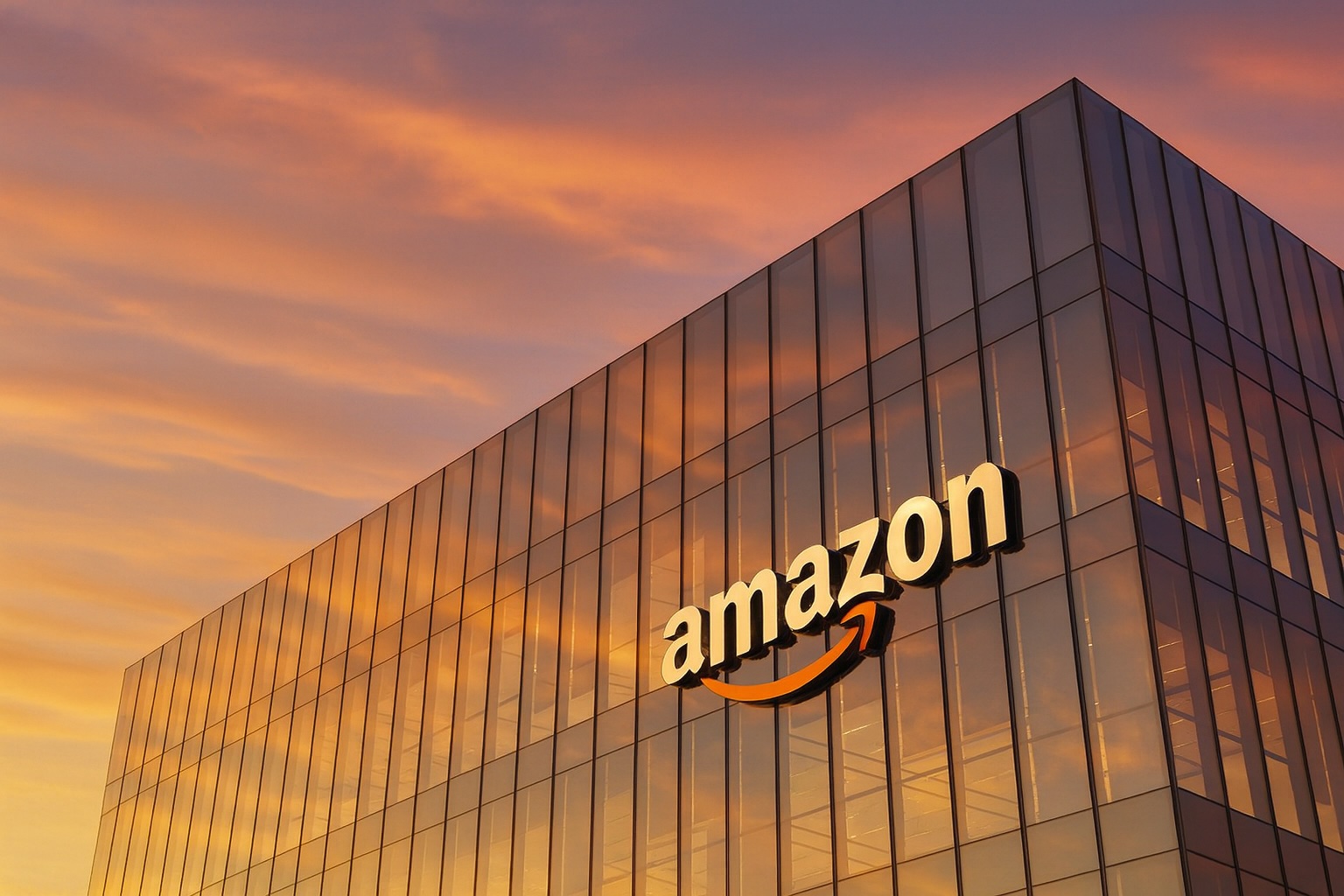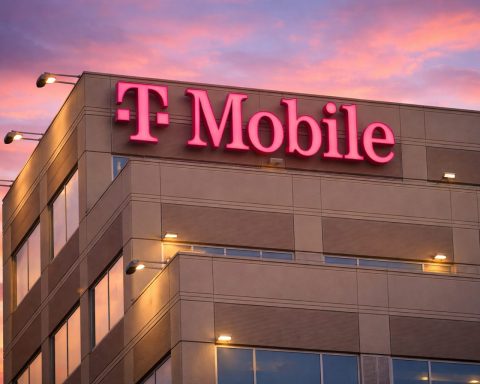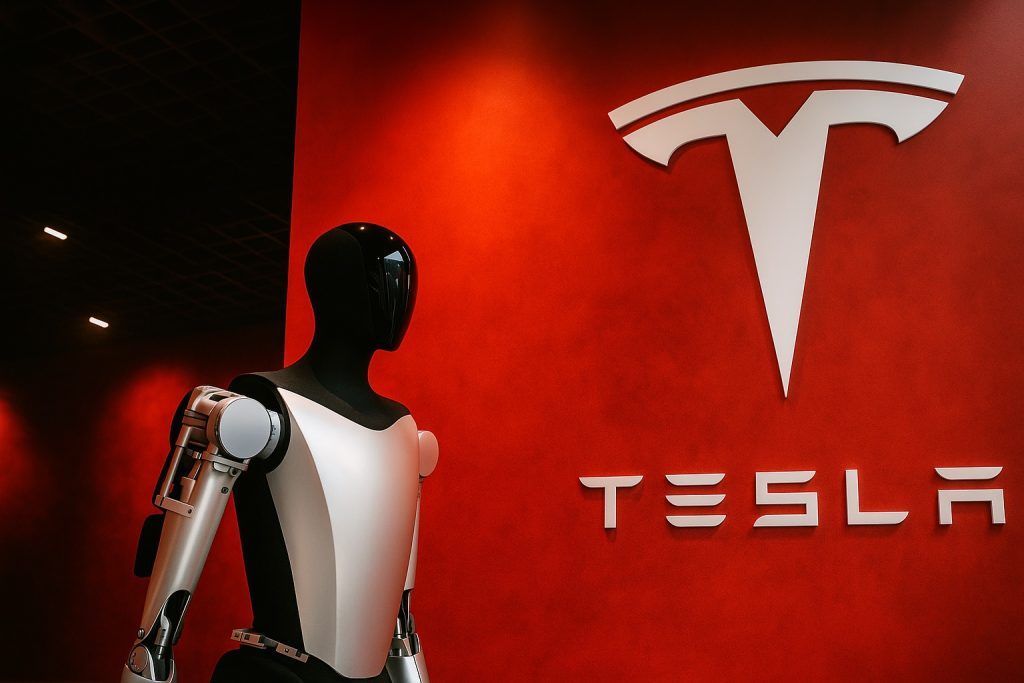Amazon’s stock has been on a tear in recent weeks, propelled by robust cloud growth and strong earnings. After languishing for much of 2025, Amazon (NASDAQ: AMZN) surged to record highs in early November. Investors are now parsing the latest results, economic conditions, and competitive moves to gauge what’s next for this tech giant’s share price. Below, we break down Amazon’s recent stock performance, key developments from November 2025, the broader market context, Wall Street’s outlook, competitive positioning, and our short- and long-term forecast for AMZN stock.
Amazon Stock Near Record Highs in Late 2025
Amazon’s share price has staged a remarkable rally heading into mid-November 2025. Following blockbuster Q3 results and optimistic guidance, AMZN jumped about 9.6% on Oct. 31 to hit an all-time high in intraday trading [1]. The stock peaked around $258 per share in early November, marking a new record closing high of roughly $254 [2]. This rally added on to a near-10% jump post-earnings and another 5% surge after a major cloud deal announcement, together adding almost $140 billion to Amazon’s market value [3]. As of the market close on Nov. 14, Amazon’s stock was trading around $238, a tad below its peak but still up about 8% year-to-date [4].
This recent climb is especially notable because Amazon had been a laggard among mega-cap tech peers for much of 2025, owing in part to perceptions it was behind in the AI race [5]. The Q3 earnings beat and renewed cloud momentum “flipped the script” on that narrative, according to JPMorgan analysts [6]. Amazon’s market capitalization now stands around $2.4–$2.5 trillion, cementing its position as one of the world’s most valuable companies – second only to Apple’s roughly $3 trillion valuation. The stock’s strong run has investors wondering if more upside remains or if a near-term breather is due after the sharp gains.
Blockbuster Q3 2025 Earnings Fuel Optimism
Amazon’s third-quarter 2025 earnings blew past expectations and set the stage for the recent rally. Net sales jumped 13% year-over-year to $180.2 billion [7], with growth across all segments. Notably, Amazon Web Services (AWS) re-accelerated to 20% revenue growth (about $33.0 billion in Q3) after several quarters of slower expansion [8]. This fastest AWS growth since 2022 was powered by relentless demand for artificial intelligence (AI) and cloud services, helping offset softer trends in e-commerce [9]. “AWS is growing at a pace we haven’t seen since 2022,” CEO Andy Jassy said, citing “strong demand in AI and core infrastructure” driving the cloud uptick [10].
Operating income came in at $17.4 billion, flat from a year ago due to hefty one-time charges [11]. Amazon absorbed a $2.5 billion legal settlement charge related to an FTC case and $1.8 billion in severance costs from corporate layoffs in Q3 [12]. Excluding those special items, operating profit would have exceeded $21 billion, underscoring underlying margin strength [13]. Net income surged to $21.2 billion (or $1.95 per share) from $15.3 billion a year earlier [14], boosted in part by investment gains. Amazon’s aggressive cost cuts – including 14,000 corporate job cuts (part of a broader 30,000 reduction plan) – and booming advertising sales (+24% YoY) also aided results [15] [16].
Investors were further encouraged by Amazon’s upbeat forecast for the holiday quarter. The company projects Q4 2025 net sales of $206–$213 billion, slightly above Wall Street’s ~$208 billion consensus [17] [18]. Hitting the high end of that range would mark roughly 11–13% growth in what is typically Amazon’s biggest quarter. Amazon has been preparing for a strong season – it announced plans to hire hundreds of thousands of seasonal workers globally (including 250,000 in the U.S.) to meet holiday demand [19]. This guidance and ramp-up suggest Amazon expects robust holiday shopping activity, despite some macroeconomic headwinds.
Wall Street cheered the Q3 beat and outlook. Amazon’s stock soared 14–15% in after-hours trading on Oct. 30, and ended Oct. 31 up 9.6% to a record high as revenue, earnings, and AWS growth all exceeded expectations [20] [21]. The one-two punch of an AWS revival and solid consumer sales appears to confirm, as one strategist put it, that “Amazon’s operations are firing on all cylinders” after a period of underperformance [22]. Jassy struck an optimistic tone on the analyst call, expressing “confidence we can continue to grow…for a while”, highlighting multiple engines of expansion from cloud to advertising and retail [23]. In short, Q3’s results have validated Amazon’s strategic direction and reinvigorated investor sentiment going into year-end.
AWS and AI Initiatives Supercharge Growth
Amazon’s cloud division AWS – long the profit engine of the company – is back in high gear, and recent strategic moves underscore its pivotal role. In early November, Amazon announced a landmark partnership with OpenAI, the creator of ChatGPT, in a seven-year, $38 billion cloud services deal [24] [25]. Under this agreement, OpenAI will run its cutting-edge AI workloads on AWS, securing access to hundreds of thousands of Nvidia GPUs and advanced Amazon EC2 UltraServers to scale its models [26] [27]. This deal is a major vote of confidence in AWS’s infrastructure, especially significant because OpenAI had been closely tied to Microsoft’s Azure cloud. News of the partnership sent Amazon’s stock up another ~5% to all-time highs, while Microsoft’s shares dipped on the development [28]. Analysts called the win “hugely significant…a strong endorsement of AWS’s capabilities” in delivering massive AI compute capacity [29] [30].
The OpenAI deal comes on the heels of AWS’s strong Q3 performance, which allayed fears that Amazon was losing ground to cloud rivals. AWS’s 20% growth beat analysts’ estimates (~18%) and “shrugged off” a brief AWS outage earlier in the quarter [31]. It also compares favorably to the “stellar” cloud revenue growth Google and Microsoft reported in the same period [32]. AWS now accounts for only ~15% of Amazon’s revenue but a hefty 60% of total operating income [33]. In other words, Amazon’s profitability is heavily leveraged to AWS, so the return to accelerating growth has been crucial for investor confidence. Importantly, Amazon is showing it can compete aggressively in AI: It has been pouring capital into AI infrastructure, with CEO Jassy emphasizing that AI investments touch “every corner of our business.” The company’s 2025 capital expenditures are on track to hit ~$125 billion (up sharply year-over-year) as it adds data center capacity and custom AI chips [34]. In Q3 alone, Amazon spent nearly $90 billion in capex through September, largely on AI projects [35].
Recent announcements highlight how Amazon is positioning AWS at the forefront of the AI boom. The company noted that its in-house Trainium2 AI chips are fully subscribed, with usage soaring 150% quarter-over-quarter, and it launched “Project Rainier,” a massive AI cluster with 500,000 Trainium2 chips to support Anthropic’s AI models [36] [37]. AWS also rolled out new cloud instance types with cutting-edge NVIDIA, Intel, AMD, and even Apple chips to attract diverse workloads [38] [39]. These moves, alongside bringing popular AI models (OpenAI, Anthropic, etc.) to its Amazon Bedrock platform, aim to ensure AWS remains the go-to cloud for enterprise AI needs [40].
All told, Amazon’s aggressive “AI everywhere” strategy is starting to pay off. Massive cloud demand for AI training and inferencing is driving AWS’s resurgence [41]. Federal Reserve Chair Jerome Powell even commented that tech sector investments in data centers and chips for AI have become a “major source of economic growth.” He noted this AI wave isn’t a 1990s-style speculative bubble – today’s AI leaders “actually have earnings,” he said, pointing to the tangible returns from AI spend [42]. Amazon is a prime example: its AI and cloud investments are translating into real revenue and profit gains, helping rejuvenate the stock. Going forward, maintaining 20%+ cloud growth will be key to Amazon’s valuation. The company believes it can – Jassy said AWS’s momentum should “continue…for a while”, thanks to no let-up in demand for AI and core cloud services [43]. With the blockbuster OpenAI deal and many AI initiatives underway, AWS is solidifying its leadership position and could be a “game changer” for Amazon’s growth narrative into 2026.
Prime Membership Trends and Retail Updates
On the retail side, Amazon’s core e-commerce business is steady, though signs of U.S. consumer saturation are emerging. Amazon has long used big sales events to recruit new Prime members, but data shows Prime sign-ups in the U.S. are slowing despite expanded promotions. In 2025, Amazon stretched its summer Prime Day into a four-day extravaganza (July 8–11) and heavily marketed the event. Yet U.S. Prime new sign-ups during the 21-day lead-up and event totaled 5.4 million, which was slightly below the prior year’s sign-ups and below Amazon’s internal targets (a ~2% shortfall) [44] [45]. Even with a “record” Prime Day in sales terms, subscriptions growth lagged. Amazon’s internal metrics showed a decline in Prime trial conversions before and during Prime Day compared to 2024 [46] [47]. The company touted “record-breaking” overall sign-ups worldwide around Prime Day, but clearly U.S. membership growth has hit a plateau, a rare peek into Amazon’s closely guarded Prime data [48]. (Reuters noted Amazon typically doesn’t disclose Prime subscriber figures, which third parties estimate around 180 million in the U.S. in 2025.)
One reason is competition: Walmart has aggressively ramped up its own membership program, Walmart+, which offers fast free shipping, streaming perks, and grocery discounts. Amazon, a pioneer in speedy delivery, now faces a serious challenger in Walmart on this front [49]. Walmart’s vast store network and improving e-commerce operations are enticing consumers with similar benefits. Amazon’s leadership knows Prime must keep evolving to stay indispensable. Accordingly, Amazon has been adding more value to Prime – from exclusive NFL Thursday Night Football broadcasts (which are drawing 15+ million viewers, up 16% YoY) [50], to a new NBA streaming package in over 200 countries [51], to bundling outside services (like adding Peacock and other streaming channels as Prime Video add-ons). These moves aim to reinforce Prime’s appeal and justify its $139 annual price tag.
Despite slower member growth, Prime remains a powerful driver of spending. U.S. Prime members on average spend over $1,100 per year on Amazon, roughly double the spending of non-members [52]. This loyalty effect underscores why “Prime is strategically very important to Amazon”, as R.W. Baird analyst Colin Sebastian noted [53]. To bolster engagement, Amazon is focused on faster delivery and convenience. Jassy highlighted that Amazon is on track to deliver to Prime members at the fastest speeds ever this year, thanks to fulfillment network innovations [54]. Same-day and next-day delivery options are being expanded, including perishable grocery delivery to over 2,300 communities and doubling coverage of same-day service in rural areas [55]. These operational improvements should help drive higher Prime usage and retention, even as membership growth matures in the U.S.
On the regulatory front, Amazon’s retail practices have drawn scrutiny. In late September, Amazon agreed to a $2.5 billion settlement with the U.S. Federal Trade Commission to resolve allegations that it deceptively enrolled customers in Prime and made it hard to cancel (so-called “dark patterns”) [56]. This record-setting settlement includes $1 billion in civil penalties and $1.5 billion in customer refunds, with millions of Prime users slated to receive automatic refunds by year-end 2025 [57]. Amazon’s Q3 earnings already reflected this cost, and the company will be implementing more transparent practices around subscriptions. Meanwhile, a separate FTC-led antitrust lawsuit (filed in 2023) is ongoing, accusing Amazon of anti-competitive practices in its marketplace. Although a long legal battle likely lies ahead, any outcome that forces Amazon to alter its marketplace fees or structure could impact its retail margins down the road. For now, though, regulatory issues have been more of a financial footnote than a fundamental threat – Amazon’s Q3 North America sales still rose a solid 11% YoY [58] despite the noise, indicating consumers remain eager to shop with the retail giant.
Economic and Market Context Impacting Amazon
Broader market forces in late 2025 present a mixed backdrop for Amazon’s valuation. High interest rates and changing Fed policy have been a key theme. After an aggressive hiking cycle in 2022–2024, the Federal Reserve finally began cutting rates in late 2025 as inflation showed signs of moderating. In October, the Fed implemented its second consecutive 0.25% rate cut, bringing the benchmark rate down to about 3.75–4.00% [59]. Fed Chair Jerome Powell indicated this “solid” easing step may be the last cut of the year and struck a cautious tone on further reductions [60] [61]. Policymakers are divided: some see room for more cuts to support a cooling job market, while others worry inflation (currently ~2.7% by core PCE) is still slightly above target and could tick up due to factors like renewed import tariffs [62] [63]. The uncertain path of monetary policy has injected volatility into equity markets. Notably, after Powell’s late-October comments, traders sharply reduced bets on a December rate cut, putting odds around 33% for another 2025 cut [64] [65].
For Amazon and other growth stocks, interest rate trends are crucial. Higher rates increase discount rates and can pressure high-multiple stocks, whereas rate cuts tend to boost growth stock valuations. The recent hint that the Fed might pause further easing “slowed” the stock rally in early November, tempering some of the euphoria around tech shares [66] [67]. Still, markets have been buoyant: the S&P 500 and Nasdaq were up for six-plus consecutive months through October [68], aided by strong earnings (over 83% of S&P companies beat Q3 estimates) and hopes that the worst of inflation is over [69]. Amazon benefited from this broader momentum, helping power the Nasdaq’s gains with its nearly 10% post-earnings surge that lifted the consumer discretionary sector [70].
On the consumer front, U.S. spending has been resilient but is showing cracks at the lower-income end. Powell described a “bifurcated” consumer: households with lower incomes are feeling stressed and pulling back, while upper-income consumers continue to spend robustly [71]. This divergence means companies like Amazon (which cater to a broad customer base) must navigate uneven demand. So far, overall retail sales and online spending remain positive. Analysts expect holiday retail sales to rise around 4% in 2025 vs. last year, a deceleration from 2024’s growth, reflecting softer consumer confidence and tighter household budgets as student loan payments resume and savings erode. Inflation, though improved from 2022 peaks, is still elevated for certain goods and services, which could make shoppers more price-conscious.
Amazon is somewhat insulated by its vast product selection and value options, but any pullback in consumer spending growth could slow its e-commerce revenue. The company’s strategy of emphasizing cost savings (e.g. holiday deals, promotions like October’s “Prime Big Deal Days”) aims to stimulate demand in a more frugal consumer environment [72]. Internationally, Amazon also faces macro variability – Europe’s economy is softer, and currency fluctuations can impact results (Q3 benefited from a $1.5B forex tailwind) [73]. Meanwhile, global trade uncertainties and tariffs (notably the Trump administration tariffs still in effect in 2025) are a wildcard for consumer prices [74] [75].
In summary, macroeconomic conditions present both headwinds and tailwinds for Amazon. High interest rates have made investors more discerning, but any clear signal of Fed easing in 2026 could further elevate growth stocks like AMZN. Consumer spending is expected to grow modestly this holiday season – not gangbusters, but not a recession either – which aligns with Amazon’s moderate yet above-consensus Q4 revenue guidance. The company’s diversified model (retail, cloud, advertising) also gives it resilience: even if retail slows, AWS and ads can buoy overall growth. Monitoring inflation and Fed signals will be important for investors, as these factors influence consumer behavior and the valuation multiples applied to Amazon’s stock.
Wall Street Analysts Boost Price Targets
Wall Street analysts are overwhelmingly bullish on Amazon as 2025 draws to a close. The strong Q3 results prompted a flurry of price target upgrades and positive commentary from major research firms. Dozens of analysts reiterated buy-equivalent ratings, and many hiked their price targets into the $300+ range for the next 12 months. For example, Citigroup reaffirmed Amazon as its “top internet stock pick” after earnings, with its analyst raising the target from $270 to $320 per share [76]. Piper Sandler and JMP Securities both set new targets at $300 [77], citing Amazon’s strong across-the-board performance and notably the 20% growth re-acceleration in AWS [78]. JPMorgan also lifted its target from $265 to $305 and noted that Amazon addressed key investor concerns on the earnings call, with the cloud outlook now much improved going into 2026 [79].
According to TipRanks data, Amazon carries a “Strong Buy” consensus rating, with 41 Buy ratings in the last three months against only a few hold recommendations [80]. The average analyst price target now hovers around $292–$296 [81] [82], implying roughly 18–20% upside from current levels. Some bullish analysts see even more headroom: for instance, the high end of recent targets reaches $320 (Citi) and one prominent five-star analyst pointed to $330 as a possibility if Amazon’s margins expand faster. A recent analysis of LSEG (Refinitiv) data showed 19 analysts calling Amazon a “Strong Buy” and 50 a “Buy,” with virtually no sells [83]. In other words, sentiment on the Street is decidedly positive.
Analysts’ optimism hinges on several factors. First, AWS’s revival is seen as a game-changer, alleviating fears about cloud competition. “AWS flipped the script,” wrote JPMorgan’s Doug Anmuth, who expects sentiment around Amazon’s cloud unit to “improve notably” in coming months if growth continues to accelerate [84]. Second, Amazon’s operating income beat (even excluding one-offs) and talk of cost discipline give confidence that profitability can scale up. Many noted Amazon’s operating margin is poised to expand in 2024–2026 as the heavy investment cycle matures and efficiency measures take hold. Additionally, Amazon’s advertising business (which grew 24% YoY) is a high-margin segment that analysts believe is still underappreciated in valuation models [85]. This fast-growing ads segment (now a $38B+ annual revenue run-rate) provides a lucrative complement to retail and cloud.
To be sure, a few voices urge some caution. With the stock back near all-time highs, valuation is a talking point – Amazon trades at a rich forward earnings multiple, so the stock “is not cheap” unless one assumes robust growth will persist. However, even value-oriented firms like Morningstar concluded after Q3 that “the stock’s nearly flat growth this year belies the company’s fundamentally strong position”, arguing the rally is justified [86]. Analysts generally agree that execution is key from here. As IG market analysts noted, Amazon is entering an investment-heavy phase, and a “re-rating” higher is likely only “provided that AWS growth accelerates into the low-20% range or better” and that Amazon’s big spending in AI/logistics translates into efficiency gains and margin improvement [87] [88]. If Amazon stumbles – say AWS growth falters back below mid-teens, or free cash flow stays constrained by capex – then the stock’s premium valuation could be challenged [89] [90]. For now though, the vast majority of analysts are betting on Amazon’s continued success, with many price targets clustering around $280–$300+ in the next year as the company’s growth engines fire on all cylinders.
Competitive Positioning vs. Tech Rivals
Amazon’s outlook can’t be fully assessed without considering its standing against major competitors in tech and retail. The company sits in an ecosystem of titans – Microsoft, Alphabet (Google), Apple, and Meta on the tech side, and Walmart and other big-box retailers on the commerce side – all vying for market share and consumer attention. Here’s how Amazon stacks up:
- Cloud Wars – AWS vs. Azure & Google Cloud: Amazon remains the world’s largest cloud provider, but Microsoft Azure and Google Cloud are formidable rivals that have been growing quickly. Earlier in 2025, some investors feared AWS was losing momentum to these competitors, especially in AI workloads. Those concerns have eased after Q3: AWS’s 20% growth actually matched or exceeded the cloud growth reported by Microsoft and Google for the comparable period [91]. Microsoft’s Azure, for instance, also saw a surge in AI-driven demand (Azure’s revenue grew approximately 33–40% YoY in its latest quarter, boosted by its OpenAI partnership), but critically OpenAI’s new $38B commitment went to AWS, not Azure. This was a notable competitive win for Amazon, given Microsoft’s close ties to OpenAI. The fact that OpenAI felt AWS’s infrastructure was superior in scaling advanced AI speaks volumes and “underscores the AI industry’s insatiable appetite for compute” that Amazon is well-positioned to supply [92] [93]. Google, meanwhile, remains a distant third in cloud market share, though it too logged impressive 20%+ growth and is investing heavily in AI chips (TPUs) and data centers. The takeaway: Amazon’s cloud unit has proven it can keep pace with – or even outpace – its peers in the key battleground of AI cloud services. As a result, Amazon has preserved its cloud leadership and dispelled the narrative that it was an AI laggard among the “Magnificent 7” mega-caps [94]. Going forward, competition will remain intense – all players are pouring billions into AI and infrastructure – but Amazon’s recent moves (custom silicon, big partnerships, global infrastructure expansion) have reinforced its competitive moat in cloud computing.
- Consumer Tech – Competing with Apple and Others: While Amazon and Apple have very different business models, they increasingly overlap in certain areas (digital services, media, and devices). Apple is currently the world’s most valuable company, and its ecosystem of iPhones, App Store, and subscription services creates a strong loyalty loop. Amazon competes by focusing on ubiquitous access and value – e.g. Alexa-powered Echo devices in the home, Fire TV streaming gadgets, Kindle e-readers, etc., all tied into Amazon’s content and retail platform. In streaming video, Amazon’s Prime Video goes up against Apple TV+ (as well as Netflix and Disney). Amazon has had success with live sports to draw in viewers (NFL, NBA, etc.), whereas Apple has invested in original shows and select sports (like MLB and MLS deals). In the latest earnings season, Apple’s results were decent but its stock stalled – Apple’s iPhone 15 launch saw strong demand, yet supply chain constraints led CEO Tim Cook to warn of product shortages, and the stock slipped 0.4% after earnings [95]. By contrast, Amazon’s results surprised to the upside and its stock jumped. This highlights how Amazon’s fortunes aren’t tied to gadget upgrade cycles in the way Apple’s are – instead, Amazon benefits from broad secular trends like e-commerce adoption and cloud computing. In terms of innovation, Amazon is integrating AI across its products (for example, improving Alexa’s capabilities with generative AI and rolling out AI-assisted shopping tools), which could help it keep pace with AI-centric features from Apple and Google. It’s worth noting that Amazon’s market cap has now closed in on Apple’s, reflecting investor views that Amazon’s growth prospects (especially in cloud and AI) justify its valuation. Apple still holds the crown in hardware and profitability, but Amazon’s diversified empire (retail, cloud, advertising, devices, media) gives it multiple levers to pull. As consumers tighten spending in some areas, Amazon’s value-oriented offerings (for example, a wide range of product price points and bundled services in Prime) could have an edge over Apple’s premium-priced products. In summary, Amazon and Apple compete at the edges – in streaming content, smart home devices, and payments – but largely dominate their own primary arenas. Both will be fighting for consumer spending this holiday season, and Amazon’s broad platform might fare better if shoppers become more cost-conscious.
- Retail Showdown – Amazon vs. Walmart: In retail, Walmart is arguably Amazon’s most direct and potent competitor, especially in the U.S. Walmart has leveraged its 4,700+ store footprint and grocery strength to grow its e-commerce business substantially. The company’s online sales have been rising by double digits, and Walmart+ (launched 2020) is adding features to rival Prime (from free shipping with no minimums to bundled streaming via Paramount+). Amazon still dominates U.S. e-commerce with an estimated ~40% market share, but Walmart is #2 and closing the gap in categories like grocery and everyday essentials. Amazon’s edge has been ultra-fast shipping and a vast third-party marketplace, but Walmart is catching up by using stores as distribution hubs and by courting marketplace sellers to its platform. As noted, Amazon’s Prime membership growth has slowed partly due to Walmart’s challenge [96] – customers now have alternatives for speedy delivery and may not see Prime as indispensable as before. Amazon has responded by investing in physical distribution (more same-day sites, Amazon Fresh stores, Whole Foods integration) and by maintaining a wide Prime benefits lead (Amazon’s bundle includes music, video, gaming, etc., which Walmart can’t fully match yet). Internationally, Amazon also faces local rivals (like Alibaba in Asia or MercadoLibre in Latin America), but in North America and Europe, traditional retailers like Walmart, Target, and Costco are its main competitors adapting to e-commerce. In recent quarters, some of these retailers have cited consumers pulling back on discretionary items but still spending on necessities – areas where Amazon and Walmart both compete (e.g. Walmart’s grocery vs. Amazon’s Whole Foods and online grocery delivery). Amazon’s competitive positioning in retail remains strong – it’s often the first stop for online shopping – but it no longer operates virtually unchallenged. The rise of Walmart’s online platform means Amazon must continue innovating in logistics and customer experience to stay ahead. The good news for Amazon is that retail is not a zero-sum game; the overall pie of online commerce is growing, and Amazon’s share can grow even as others expand. Also, Amazon’s third-party marketplace model (with millions of sellers) gives it breadth and selection advantage that is hard for a single retailer to replicate. Still, investors will be watching how Amazon defends its retail turf in 2026, especially if economic conditions cause consumers to become more value-oriented (a scenario that traditionally favors Walmart and Target).
In summary, Amazon enters 2026 in a position of competitive strength, but not invincibility. It has regained momentum against cloud peers, is keeping pace in the AI race, and continues to dominate online shopping even as rivals step up. Each major competitor presents a different challenge – Microsoft in cloud and AI ecosystems, Google in ads and cloud, Apple in devices and media, and Walmart in retail and logistics. Amazon’s broad diversification gives it multiple competitive advantages, yet it also means Amazon has many fronts to manage. The company’s Q3 showed it can execute well across divisions. Maintaining that execution – continuing to innovate faster than rivals and leveraging its scale – will be critical for Amazon to sustain its market leadership in the coming years.
Outlook and Forecast for AMZN Stock
Near-Term (Next 3–6 months): The short-term outlook for Amazon’s stock is cautiously optimistic. The holiday quarter is typically Amazon’s strongest, and Q4 2025 is shaping up to be solid. With management forecasting up to $213 billion in sales (a record high) and hiring en masse for peak season [97], we anticipate double-digit revenue growth and robust earnings for Q4. Strong holiday performance – if delivered – could act as a catalyst for the stock early in 2026 when results are reported. Additionally, any signs of inflation easing further or the Fed indicating rate cuts in early 2026 would likely boost sentiment for big tech stocks like Amazon. That said, after the recent run-up, AMZN shares may see some consolidation or volatility in the very near term. Technically, the stock is hovering around the mid-$230s to $240s, a range it has struggled to break out of after pulling back from $258 highs [98] [99]. This “digestion” of gains is normal as investors lock in some profits and await the next data point. Key things to watch in the coming months include: holiday sales metrics, any updates on AWS customer wins or cloud growth (Amazon often gives a qualitative business update in January), and macro news (jobs and inflation data influencing Fed policy). We’ll also watch Amazon’s own moves – for instance, pricing changes (e.g. any Prime fee adjustments or promotions) and costs (shipping cost inflation, etc.). Overall, we expect AMZN to trade in a higher range than earlier in 2025, supported by improving fundamentals. A reasonable near-term base case is the stock stabilizes between roughly $235 and $255, with a bias to the upside if earnings impress. Downside risks in the short run would be if holiday consumer spending significantly disappoints or if AWS shows any unexpected slowdown in Q4 – neither of which is anticipated given current indicators.
Long-Term (2026 and beyond): We remain bullish on Amazon’s longer-term prospects. The megatrends driving Amazon’s businesses – e-commerce adoption, cloud/AI proliferation, digital advertising – are intact and likely have years of growth ahead. Amazon’s hefty investments in 2023–2025 (from warehouse automation to AI chips) should start yielding higher efficiency and new revenue streams in 2026+. For example, as AWS’s new data centers and hardware come online, Amazon can capture surging AI demand (as evidenced by the OpenAI deal’s multi-year ramp) and potentially even expand cloud market share. On the retail side, Amazon’s push for ever-faster delivery and its expansion into grocery and healthcare could unlock new customer segments and increase wallet share among Prime members. The company’s advertising arm, already a $40B business, is likely to continue growing above 20% annually as more brands allocate budget to Amazon’s ecosystem (search ads, video ads on Prime, etc.) [100]. This diversifies Amazon’s profit streams beyond AWS and retail. Analysts widely expect Amazon’s earnings to compound at a high teens rate over the next 5 years, and many have penciled in stock price targets in the high-$200s to $300+ accordingly [101] [102]. For instance, fundamental models from several banks suggest AMZN could reach the $280–$300 range in 12–18 months if growth stays on track [103]. Our own view is that Amazon stock could indeed hit the $300 milestone in the next year or two, which would equate to roughly a $3 trillion market cap, provided the company executes well on key metrics.
What are those key metrics? Going into 2026, we’re watching AWS revenue growth (needs to sustain high-teens or better), operating margins (expected to improve as one-off costs abate and efficiency kicks in), and free cash flow (which should recover as heavy capex begins to moderate by 2026) [104]. If Amazon delivers on these fronts – say AWS growth stays ~20%+, retail grows high-single digits with stable margins, and advertising stays 20%+ – then earnings will scale up and justify further stock appreciation. In such a scenario, it’s not hard to envision Amazon approaching $10+ in EPS in a couple of years, which at a multiple of ~30x could support a ~$300 stock price. On the longer horizon (3–5 years), Amazon’s opportunities in new arenas like AI services, automation/robotics, and international expansion (India, Latin America) provide additional upside optionality.
However, investors should also keep in mind risks and wildcards. The regulatory environment is one: the ongoing FTC antitrust suit could result in remedies that alter how Amazon marketplace operates (for example, curbing preferential treatment of its own products or lowering fees for third-party sellers). While a breakup of Amazon appears unlikely, any enforced changes could introduce new costs or competition on the platform. Another risk is competitive pressure – rivals are not standing still. Microsoft, Google, and Oracle are vying for cloud deals (and could undercut on price), Walmart and others will keep pressing in e-commerce (perhaps sacrificing margin for market share), and entirely new competitors could emerge in areas like AI commerce. Execution risk is also non-trivial: Amazon’s management is juggling massive projects (from satellite internet with Project Kuiper to integrating Whole Foods to building AI products). With over 1.5 million employees, keeping focus and maintaining Amazon’s high-performance culture is an ongoing challenge (one that prompted recent layoffs to remove “redundant” layers [105]). Any significant stumble in customer experience – be it a serious AWS outage, a holiday delivery debacle, or a PR scandal – could quickly erode investor confidence, though Amazon has a strong track record on operational excellence.
In our view, the bull case for Amazon outweighs the bear case as we head into 2026. Amazon has proven adaptable through various economic cycles, and its strategic bets (like AI and international growth) position it well for the future. The company’s diversification across tech and retail provides a balance that few others have – strength in one segment can offset weakness in another. Furthermore, if macroeconomic conditions improve (e.g. interest rates gradually fall and consumer spending picks up), Amazon stands to be a prime beneficiary given its sensitivity to both consumer and enterprise demand. Many analysts are already talking about Amazon’s potential to eventually join Apple in the exclusive $3 trillion market cap club [106]. While such milestones are never guaranteed, the path is becoming clearer: it will require continued double-digit growth, margin expansion, and steady buy-in from investors that Amazon can deliver on its ambitious roadmap.
Bottom Line: Amazon’s stock has regained momentum in late 2025, reflecting the company’s renewed growth in AWS and resilient retail performance. Short-term, the stock may take a breather after its big rally, but upcoming catalysts like holiday earnings and any positive Fed signals could spur further gains. Long-term, Amazon’s fundamentals appear strong – the company is riding powerful trends and has the scale to invest through challenges. We expect AMZN to trend higher over the next 12–24 months, albeit with the typical volatility that comes with a richly valued tech leader. Investors should remain aware of macro and competitive risks, but at this juncture, Amazon’s diverse strengths and strategic initiatives give it a favorable outlook. In the words of CEO Andy Jassy, Amazon has “strong momentum right now” [107], and if that momentum is maintained, the stock’s recent highs may prove to be stepping stones to even greater heights in 2026.
References
1. www.businesstoday.com.my, 2. www.ig.com, 3. www.reuters.com, 4. www.ig.com, 5. www.reuters.com, 6. www.tipranks.com, 7. www.ig.com, 8. www.ig.com, 9. www.reuters.com, 10. www.reuters.com, 11. www.ig.com, 12. www.ig.com, 13. www.ig.com, 14. www.ig.com, 15. www.reuters.com, 16. www.reuters.com, 17. www.reuters.com, 18. www.reuters.com, 19. ir.aboutamazon.com, 20. www.businesstoday.com.my, 21. www.ig.com, 22. www.reuters.com, 23. www.reuters.com, 24. www.reuters.com, 25. www.reuters.com, 26. www.reuters.com, 27. www.reuters.com, 28. www.reuters.com, 29. www.reuters.com, 30. www.reuters.com, 31. www.reuters.com, 32. www.reuters.com, 33. www.reuters.com, 34. www.reuters.com, 35. www.reuters.com, 36. ir.aboutamazon.com, 37. ir.aboutamazon.com, 38. ir.aboutamazon.com, 39. ir.aboutamazon.com, 40. www.aboutamazon.com, 41. www.reuters.com, 42. www.reuters.com, 43. www.reuters.com, 44. www.reuters.com, 45. www.reuters.com, 46. www.reuters.com, 47. www.reuters.com, 48. www.reuters.com, 49. www.reuters.com, 50. ir.aboutamazon.com, 51. ir.aboutamazon.com, 52. www.reuters.com, 53. www.reuters.com, 54. ir.aboutamazon.com, 55. ir.aboutamazon.com, 56. www.ig.com, 57. www.ftc.gov, 58. ir.aboutamazon.com, 59. www.reuters.com, 60. www.reuters.com, 61. www.reuters.com, 62. www.reuters.com, 63. www.reuters.com, 64. www.reuters.com, 65. www.reuters.com, 66. www.businesstoday.com.my, 67. www.businesstoday.com.my, 68. www.businesstoday.com.my, 69. www.businesstoday.com.my, 70. www.businesstoday.com.my, 71. www.reuters.com, 72. www.emarketer.com, 73. ir.aboutamazon.com, 74. www.reuters.com, 75. www.reuters.com, 76. www.tipranks.com, 77. www.tipranks.com, 78. www.tipranks.com, 79. www.tipranks.com, 80. www.tipranks.com, 81. www.tipranks.com, 82. www.ig.com, 83. www.ig.com, 84. www.tipranks.com, 85. www.reuters.com, 86. www.reuters.com, 87. www.ig.com, 88. www.ig.com, 89. www.ig.com, 90. www.ig.com, 91. www.reuters.com, 92. www.reuters.com, 93. www.reuters.com, 94. www.reuters.com, 95. www.businesstoday.com.my, 96. www.reuters.com, 97. ir.aboutamazon.com, 98. www.ig.com, 99. www.ig.com, 100. www.reuters.com, 101. www.ig.com, 102. www.tipranks.com, 103. www.ig.com, 104. www.ig.com, 105. www.reuters.com, 106. 247wallst.com, 107. www.reuters.com









